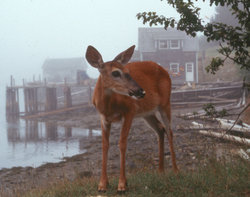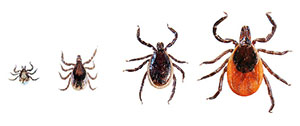Multivariate Modeling of Ticks, Climate, and Disease in Maine
Susan Elias is a Ph.D. candidate and Integrative Graduate Education and Research Traineeship (IGERT) Adaptation to Abrupt Climate Change (A2C2) fellow at the Climate Change Institute at the University of Maine. Advised by Kirk Maasch in the Earth and Climate Sciences Department, Elias’ research focuses on improving multivariate modeling to inform strategies for adapting to the spread of tick- and mosquito-borne diseases in Maine.
Spring weather drives Mainers and visitors outside to work and recreate, but also signifies the start of tick season. This is an unfortunate combination as ticks are being found in greater numbers and across larger regions of Maine, making tick-borne diseases of increasing concern across the state. Deer ticks are of particular importance, as these tiny arachnids now carry five pathogens known to cause disease in humans, including Lyme Disease, a potentially long-term debilitating condition. Other tick-borne diseases include anaplasmosis, babesiosis, fever caused by Borrelia myamotoi, and Powassan encephalitis. Co-infection by two or more pathogens may intensify illness.

“Maine in 2014 had the highest incidence of Lyme Disease of all the states in the country,” with Midcoast Maine and islands being hardest hit. “We’ve got to get this figured out,” says Susan Elias, a Ph.D. student at the Climate Change Institute (CCI).
Elias is studying deer ticks and their spread across the state and conducts similar research on mosquitoes, by using rich data sets and multivariate modeling software. Elias’ path to this research started in the 1990s at the University of Maine’s Holt Research Forest. That position led her to work as a statistician at the Vector-borne Disease Lab (VBDL) at Maine Medical Center Research Institute. As a result of her years of experience in ecology, ticks, and pathogens, Elias has gained a better understanding of not only ticks but also the many factors that influence their spread. The impacts of human exposure to ticks are also something she is examining. This expertise is necessary to keep Mainers healthy in a state witnessing an increase in ticks and tick-related diseases.
“If we just have a better understanding of all the factors taken together, I think we could do a better job of helping people control deer ticks and prevent disease,” says Elias.
Previous collaborations between the Vector-borne Disease Lab and the Climate Change Institute have shown that the occurrence of tick-borne disease in humans is correlated with the number of deer ticks present in Maine. Further, deer tick numbers (and hence the occurrence of tick-borne diseases) is correlated with warmer temperatures and increased humidity. This is because warmer winters extend the feeding season for adult ticks, resulting in more eggs laid in the spring, and increased summer humidity benefits deer ticks during a life stage that requires more moisture. Data already show Maine’s climate is trending towards these conditions, and indeed the number of deer ticks and cases of human disease have been increasing over the past few decades.
But climate change is not the only variable that affects how deer ticks spread and affect human health. Changes in animal habitat, deer density, small mammal host density, habitat for ticks and their hosts, and land use all affect deer ticks and their influences on human health. Elias’ modeling, based on existing tick and small mammal data sets, and with help from UMaine climate scientists, aims to better integrate these variables. While current models can show a correlation between temperature and deer ticks, for example, Elias’ modeling will take into account numerous factors at once, and also indicate the relative importance of each.

And because variables as different as deforestation or reforestation, lawn care decisions, natural and chemical pest, and herbicide use, increased air travel, deer hunting regulations, bird and small mammal health, and local weather patterns due to global climate change can all affect human health, it is important to understand the relative contribution each variable has on tick and pathogen spread. Results of Elias’ modeling will, therefore, help focus resources and efforts on those variables that are most likely to lead to increased disease in humans. Should money be allocated to tick vaccines, removal of invasive plants, deer management, or something else? Elias’ models will help answer these questions and inform adaptation strategies in both private and public sectors for dealing with a more tick-ridden world.
Author: A. Sasha Breus, May 2016
To learn more about ticks, visit the Vector-borne Disease Lab’s page (Maine Medical Center Research Institute website), and the UMaine Extension Tick Identification page.
All photos taken from Ticks In Maine by Maine Medical Center Research Institute’s Vector-borne Disease Laboratory
